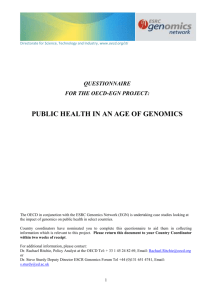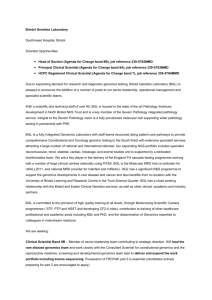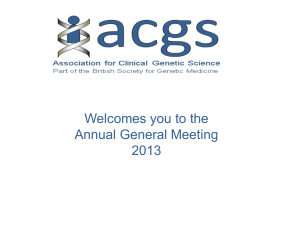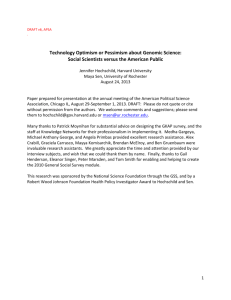ACGS draft response - Association for Clinical Genetic Science
advertisement
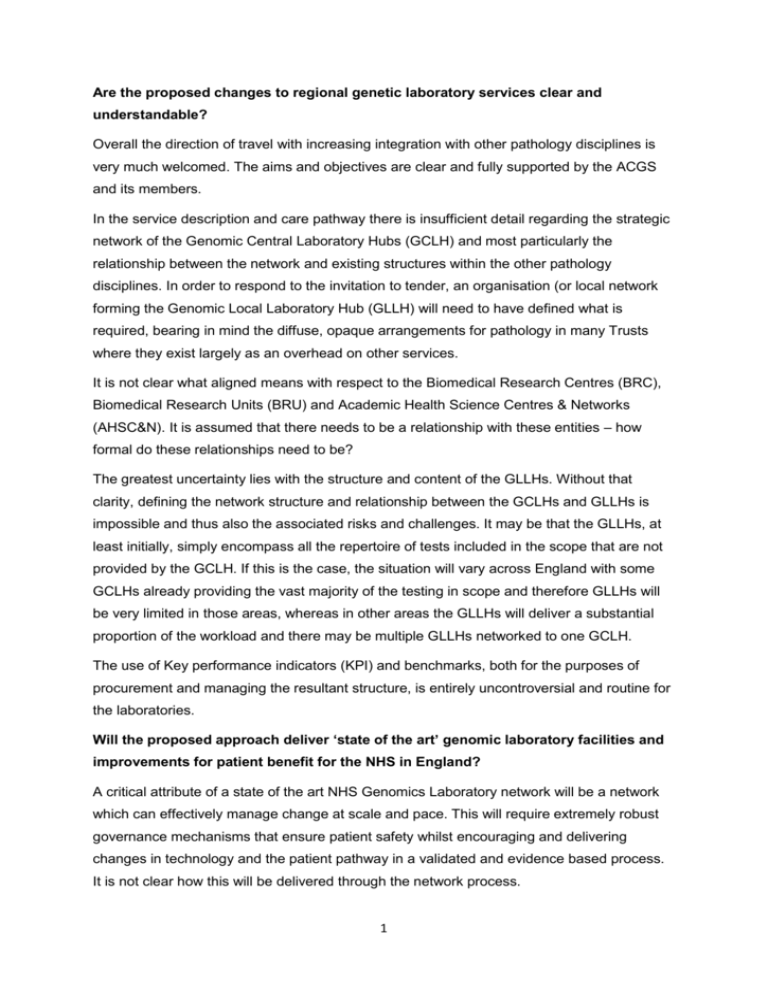
Are the proposed changes to regional genetic laboratory services clear and understandable? Overall the direction of travel with increasing integration with other pathology disciplines is very much welcomed. The aims and objectives are clear and fully supported by the ACGS and its members. In the service description and care pathway there is insufficient detail regarding the strategic network of the Genomic Central Laboratory Hubs (GCLH) and most particularly the relationship between the network and existing structures within the other pathology disciplines. In order to respond to the invitation to tender, an organisation (or local network forming the Genomic Local Laboratory Hub (GLLH) will need to have defined what is required, bearing in mind the diffuse, opaque arrangements for pathology in many Trusts where they exist largely as an overhead on other services. It is not clear what aligned means with respect to the Biomedical Research Centres (BRC), Biomedical Research Units (BRU) and Academic Health Science Centres & Networks (AHSC&N). It is assumed that there needs to be a relationship with these entities – how formal do these relationships need to be? The greatest uncertainty lies with the structure and content of the GLLHs. Without that clarity, defining the network structure and relationship between the GCLHs and GLLHs is impossible and thus also the associated risks and challenges. It may be that the GLLHs, at least initially, simply encompass all the repertoire of tests included in the scope that are not provided by the GCLH. If this is the case, the situation will vary across England with some GCLHs already providing the vast majority of the testing in scope and therefore GLLHs will be very limited in those areas, whereas in other areas the GLLHs will deliver a substantial proportion of the workload and there may be multiple GLLHs networked to one GCLH. The use of Key performance indicators (KPI) and benchmarks, both for the purposes of procurement and managing the resultant structure, is entirely uncontroversial and routine for the laboratories. Will the proposed approach deliver ‘state of the art’ genomic laboratory facilities and improvements for patient benefit for the NHS in England? A critical attribute of a state of the art NHS Genomics Laboratory network will be a network which can effectively manage change at scale and pace. This will require extremely robust governance mechanisms that ensure patient safety whilst encouraging and delivering changes in technology and the patient pathway in a validated and evidence based process. It is not clear how this will be delivered through the network process. 1 Future-proofing will also require that the organisations in the network have robust mechanisms to disseminate developments where the patient agenda takes precedence over for example research interests. This can be challenging where there are close links to research groups, which benefit the patient by fostering development but also have concerns regarding Intellectual Property (IP). It may be that the strategic network will have a role in managing this and/or the AHSNs and/or Collaboration for Leadership in Health Research and Care (CLAHRC). State of the art will be determined and driven ultimately by the funding and commissioning mechanisms which must be aligned to deliver equity. In addition there will be internal pressures from the host trusts which may impact unevenly upon the GCLHs and GLLHs and lead to in equity. It would be helpful to have a more defined relationship with the host trusts if that is possible. Underlying the ongoing success and development of the Genomics network will be training and education. The ACGS plays an active role in this, across the professional groups and welcomes the inclusion of this in the aims and objectives. NHS England preferred approach is to commission genetic laboratory services for patients over seven days a week in line with plans for other NHS services. Do you agree with this approach? A key element of the specification is a more integrated approach with other pathology disciplines. We recognise also that the developing MSC programme involve integration across disciplines of all pathology staff into common structures, initially for training but ultimately to deliver a diagnostic process more tailored to the patient and the patient pathway. Other disciplines are already working in a 7 day or 24/7 environment and this will necessitate the genetics laboratories aligning to this. We should not been seen as “exceptional”. However it is crucial, in this financial environment that this is addressed using a systematic approach; a key part of the role of the NHS Genomics laboratory structure and the GCLHs will be to establish transition pilots to identify how best to deliver extended working hours whilst containing cost. Are there any inequality/health equalities issues which you think should be considered in making a decision about the future delivery of genetic laboratory services in England? It is clear that there is not an equitable delivery nor managed development of genetic services with patients having differing access to tests across the country with differing 2 standards of delivery eg Turnaround Times (TATs). This is constantly changing and evolving, not necessarily for the better, and underlying are many factors contributing to an immensely complex issue. The main factors are funding and commissioning (which includes the arrangements within host Trusts); and delivery of existing services where differing technologies, staff structures and management produce services of different standards when considering agreed KPIs such as TATs and level of analysis required/appropriate. Also there is variation that is not captured by the existing KPIs, though the Best Practice Guidelines go some way towards correcting this. However these problems are not unique to genetics and genomics and key will be to establish mechanisms within, and more importantly between GCLHs, to ensure that equity is achieved. Number of GCLHs and equity: it is important that there are robust mechanisms in place which ensure that all patients get access to the same quality of testing including TAT. For tests with a rapid TAT where there is, as yet, no Point of Care Testing, this will require robust sample transfer or development of local delivery at the GLLHs with the possibility of outsourcing the analysis/interpretation to the GCLH which will allow expertise to the centralised, more robust cover and standardisation. However with rationalisation of genetic testing between the GCLHs there will be a requirement for sample referral and exchange to be improved and streamlined. This should be an explicit requirement in the specification. In addition there needs to be continuing development of the capability of the UKGTN and the content and structure of the Catalogue of Laboratory Medicine to enable labs to refer samples to the correct laboratory rapidly and automatically. Number of GCLHs and research: An active genetics/genomics GCLH should be and will be an asset to the local research activity of Universities and Medical Schools and will contribute to and drive forward research and research ideas. It will be imperative that the specification addresses this and includes a requirement for planning regarding the research environment , to ensure that cities and city regions are not disadvantaged by loss of a genetics/genomics facility. Number of GCLHs and pathology: this has been at least in part addressed by the formation of GLLHs and the local networks; however this needs further clarification. IT infrastructure will need to be addressed to ensure that there are not inequities introduced by failure of data transfer or sharing. There needs to be more explicit requirements regarding IT infrastructure. Are there any other considerations which need to be taken into account, which have not been covered in the proposals? 3
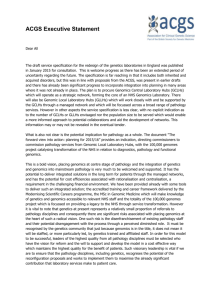
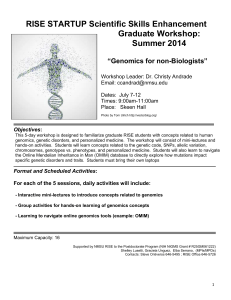
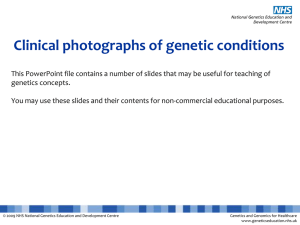
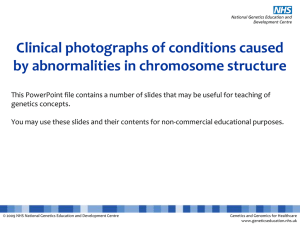
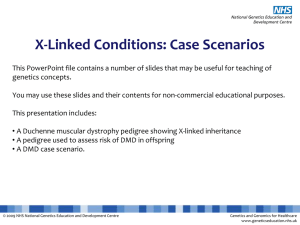
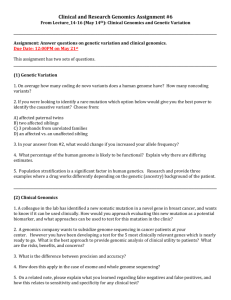
![9_Komlenac - start [kondor.etf.rs]](http://s2.studylib.net/store/data/005352037_1-bdc91b0717c49a75493200bca431c59c-300x300.png)
